What Do Symbols on a Fire Extinguisher Indicate? | State College, PA
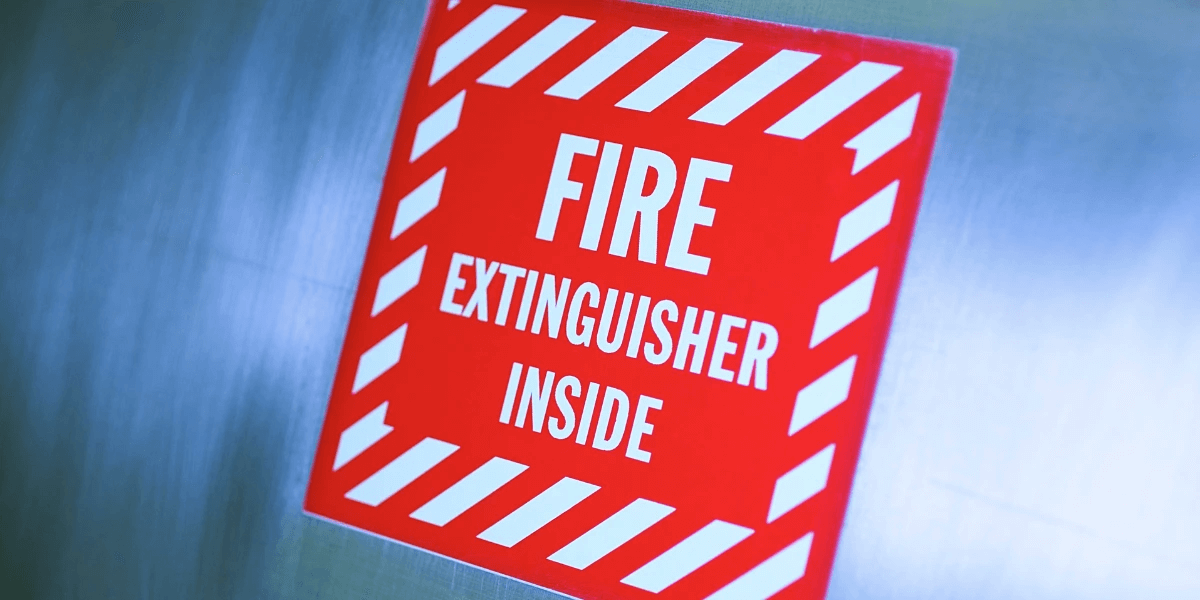
Let's talk about fire safety and why everyone needs to get it right, especially when it comes to fire extinguishers.
These gadgets are pretty much everywhere—from your home kitchen to just about any workplace you can think of. This is because they play a significant role. Fire extinguishers are crucial because they can save lives and property by putting out fires before they get out of control.
Now, onto a big question: What do the symbols on a fire extinguisher indicate? Knowing this is essential for safety. These tell you exactly what kind of fire you can use the extinguisher on. This is super important because using the wrong type of extinguisher can make a fire worse—imagine trying to use a water extinguisher on grease fires!
We're going to break down these symbols and explain why knowing about them is key to using fire extinguishers correctly. Knowing this stuff can make a huge difference in a fire emergency. Let's get you up to speed.
Key Takeaways
- Fire extinguisher symbols provide critical information on their appropriate use for specific fire classes.
- Proper identification and use of fire extinguishers can significantly enhance safety and effectiveness in emergency situations.
- Regular maintenance, training, and familiarization with your fire extinguisher are essential for preparedness and safety.
The ABCs and Ds of Fire Extinguishers
Fire extinguisher labels are packed with vital information. At first glance, they might seem like a mix of letters, symbols, and numbers, but each piece of information has a specific meaning that can help you act effectively in a fire situation.
Purpose of labels and symbols
The main goal of these labels and symbols is to quickly communicate what types of fires a particular extinguisher can be used on. Given that fires can start from various sources—like electrical equipment, flammable liquids, or even cooking oils—it's essential to match the fire type with the correct extinguisher.
Using the wrong type can be dangerous, such as attempting to use a water-based extinguisher on an electrical fire, which could lead to electrocution or make the fire worse.
Fire classes, symbols, and their meaning
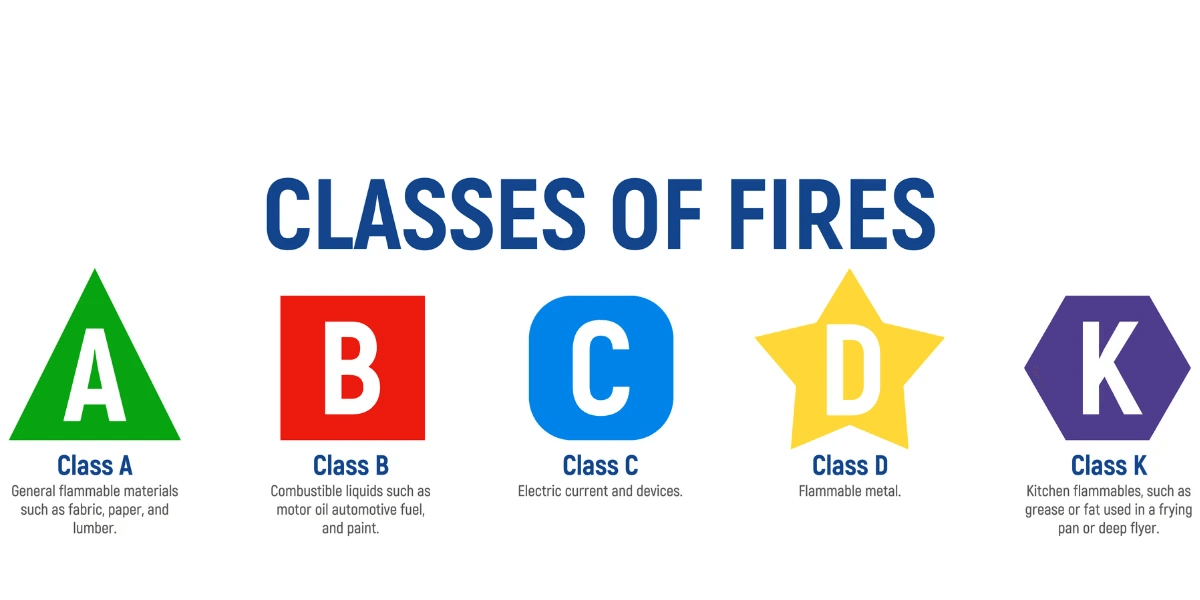
The classification of fire extinguishers into Classes A, B, C, D, and K is standardized by the National Fire Protection Association (NFPA), ensuring uniformity and understanding across various settings. Here's a breakdown of what each class represents and the corresponding symbols:
Class A (Ordinary combustibles)
This type of extinguisher is suitable for "ordinary combustibles" like wood, paper, textiles, and some plastics.
The symbol for Class A fire extinguishers is a green triangle with the letter A inside. The pictogram is a trash bin with fire on top and firewood on its side. This symbol is straightforward, indicating that the extinguisher is designed to tackle fires leaving ash.
Class B (Flammable liquids and gases)
Class B fires are for flammable liquid fires, those involving gasoline, oil, propane, or paint. This class uses a red square symbol with the letter B inside. The pictogram is of a fuel can. The presence of the can alerts users to the type of fire risk associated with these materials.
Class C (Electrical fires)
Class C fires are electrical fires. Class C fire extinguishers are designed to fight fires involving energized electrical equipment without the risk of conducting electricity back to the user.
The Class C symbol is a blue circle with the letter C inside. The pictogram often includes an electrical plug or a lightning bolt to denote that it's safe for use on electrical fires.
Class D (Combustible metals)
A Class D rating indicates the extinguisher can be used on combustible metals, which are common in certain industrial settings.
Class D fire extinguishers are denoted with a yellow star symbol with the letter D inside. The pictogram is of a metal beam on fire to signify fires involving metals like magnesium, sodium, or potassium, which require specific extinguishing agents.
Class K (Kitchen fires)
Class K fires involve cooking oils and fats, which are typically found in commercial kitchens.
These extinguishers display a black or purple hexagon with the letter K inside. The pictogram is of a cooking pan. Given the unique nature of these fires, the pictogram quickly communicates the extinguisher's suitability for kitchen and cooking-related fires.
Other fire extinguisher ratings
In addition to these class symbols, fire extinguishers also carry ratings like "2A" or "10B." These ratings give you an idea of the extinguisher's effectiveness and coverage area.
For example, a 2A rating equals the extinguishing power of 2.5 gallons of water, suitable for Class A fires, while a 10B rating indicates the extinguisher can cover about 10 square feet of a Class B fire.
Fire extinguisher labels may also include specific instructions for use, maintenance records, and inspection tags, ensuring they are ready to operate when needed. The presence of a UL (Underwriters Laboratories) mark means the extinguisher meets strict standards for safety and effectiveness.
Visual guidance for quick decision-making
The beauty of these pictograms lies in their ability to convey essential information swiftly and universally. In the urgency of a fire emergency, there’s no room for hesitation or reading lengthy instructions. These symbols cut through the panic, allowing individuals to identify the correct extinguisher type at a glance.
For instance, spotting the square symbol on an extinguisher tells you instantly that it’s meant for a flammable liquid fire without needing to read a word. Similarly, the electrical symbol on a Class C extinguisher reassures you that it’s safe to use on fires involving electrical equipment, addressing any concerns about conductivity and safety.
Types of Fire Extinguishers
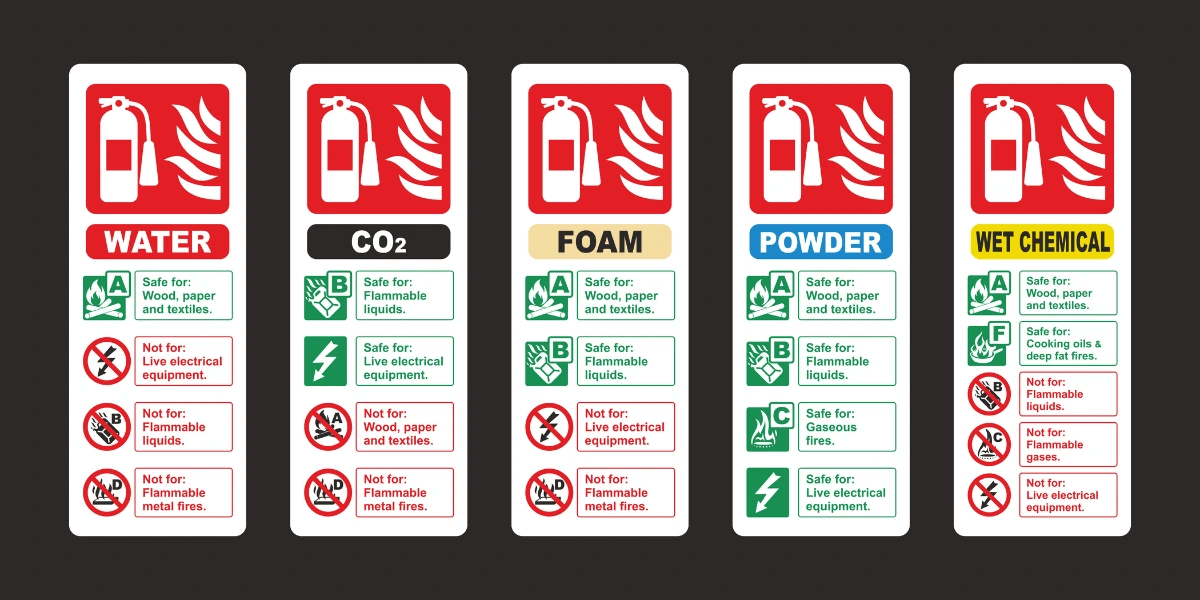
Aside from symbols, you might also see that the fire extinguisher's label has a color code. Those labels denote what kind of fire extinguisher they are. Let's talk about the different types of extinguishers and what their colors mean.
Water extinguishers
These are ideal for Class A fires. Water cools the burning material, extinguishing the fire. However, it's not suitable for grease, oil, electrical fires, or flammable liquids because it can spread the fire or conduct electricity.
These usually come with red labels.
Foam extinguishers
These are effective on Class A and B fires, including flammable liquids such as gasoline. The foam is an extinguishing agent that forms a barrier between the fire and the fuel, preventing the oxygen from feeding the flames.
These usually come with cream-colored labels.
Dry powder extinguishers
Versatile and effective on Class A, B, and C fires, dry powder extinguishers can tackle fires involving flammable gases, liquids, and electrical fires. The powder interrupts the chemical reaction that fuels the fire.
Blue labels are used on these.
CO2 extinguishers
Carbon Dioxide extinguishers are best for Class B and C fires, especially effective on electrical fires as CO2 doesn't conduct electricity and doesn't leave a residue that could harm sensitive equipment.
These carry a black label.
Wet chemical extinguishers
Specifically designed for Class K fires in kitchens, involving cooking oils and fats. Wet chemicals create a soap-like solution that cools and smothers the fire, preventing re-ignition.
These are identified by their yellow labels.
How to Use a Fire Extinguisher: The PASS Method
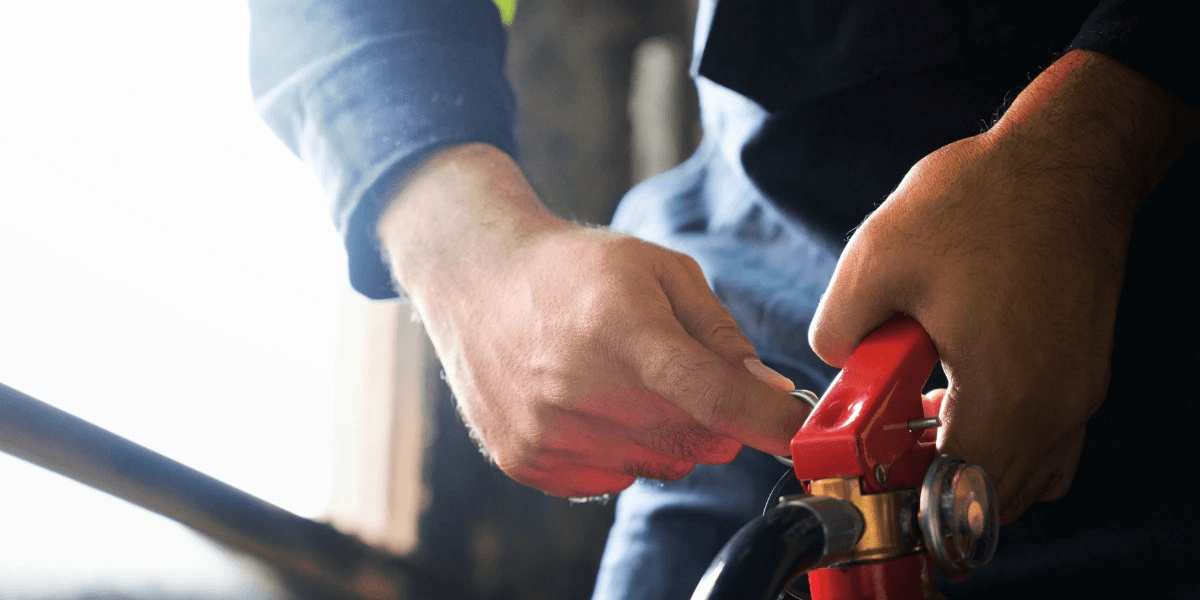
Following our exploration of fire extinguisher types and the color-coding system that helps in their identification, it's vital to know how to use these devices effectively in an emergency. The PASS method is a simple, universally recognized procedure for operating most fire extinguishers.
Here’s a step-by-step guide to using a fire extinguisher with the PASS acronym, along with safety precautions to keep in mind.
P - Pull the pin
Every fire extinguisher comes with a pin inserted into the handle that prevents accidental discharge. Start by pulling the pin out. This action will also break the tamper seal.
A - Aim low
Point the extinguisher’s nozzle (or hose) at the base of the fire. Targeting the flames directly won't stop the fire. You need to extinguish the material that's fueling the fire.
S - Squeeze the lever
Squeeze the lever slowly and evenly to release the extinguishing agent. Releasing the lever will stop the discharge. Practice firm, controlled pressure to maintain a steady stream of the agent.
S - Sweep from side to side
Move the nozzle or hose from side to side until the fire appears to be out. Start from a safe distance, a few feet away, and move closer once the fire starts to diminish. Be sure to cover the area thoroughly to prevent re-ignition.
Safety Precautions When Using an Extinguisher
One final thing about using fire extinguishers: you should know the precautions.
- Know your extinguisher: Before an emergency arises, familiarize yourself with the type of fire extinguishers available in your environment and their operating instructions. Not all extinguishers work on all types of fires.
- Assess the situation: If the fire is too large or the environment too risky (e.g., the potential for explosion, toxic smoke, or lack of escape route), evacuate immediately and call the fire department.
- Ensure a safe escape route: Always keep yourself between the fire and an exit. You should be able to back away from the fire towards a safe exit if the fire cannot be extinguished or becomes uncontrollable.
- Avoid smoke inhalation: Fires can produce dangerous gases. Avoid breathing in smoke or fumes, and evacuate if you start to cough or feel dizzy.
- Regular maintenance checks: Ensure that extinguishers are regularly checked and maintained according to the manufacturer's instructions and local fire codes. A fire extinguisher that doesn't work can be more dangerous than no extinguisher at all.
- Training: If possible, attend a fire extinguisher training course. Hands-on experience can significantly improve your ability and confidence to act effectively in a real emergency.
Protect What Matters Most
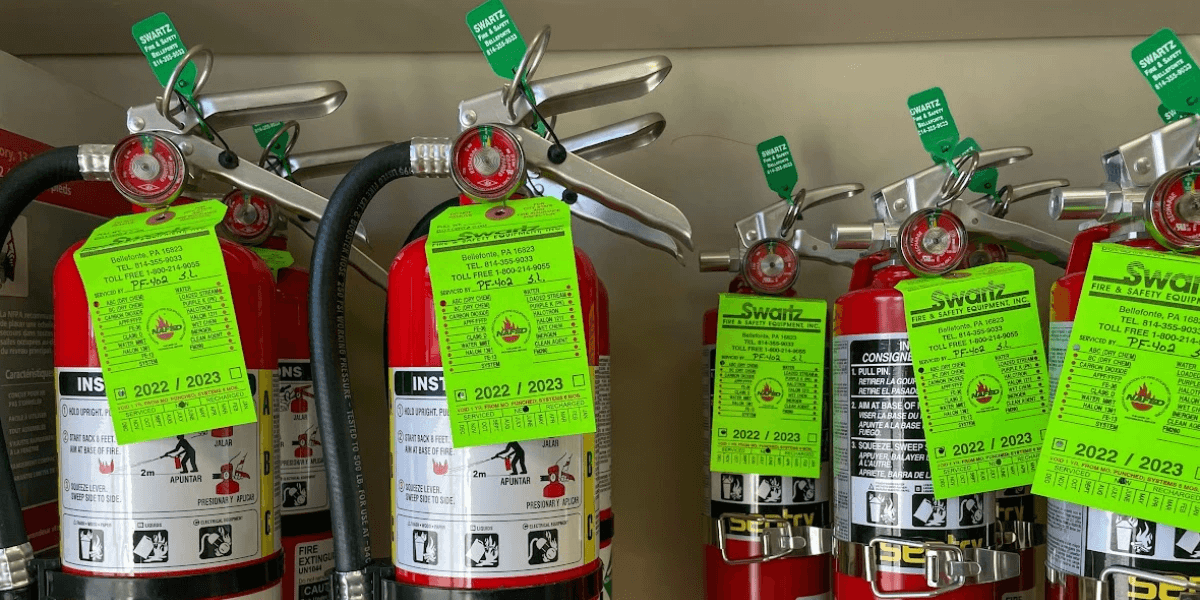
Choosing the right fire extinguisher shouldn't be complicated. With Swartz Fire & Safety, you gain access to the best products, expert installation, and training services that empower you to protect what matters most.
Swartz Fire & Safety is your trusted partner in fire protection, offering top-tier fire extinguishers, installation, maintenance, inspection, and training services across Central Pennsylvania. With over 40 years of experience, we're dedicated to ensuring your safety with expert solutions tailored to your needs.
Need a reliable fire extinguisher or expert safety training?
Contact us today. Our certified team is ready to equip you with the right tools and knowledge to protect against fire risks. Take a step towards comprehensive fire safety!
Frequently Asked Questions
What do markings on fire extinguishers mean?
Markings on fire extinguishers identify the classes of fires they are designed to extinguish, with each symbol representing a specific fire class—A for ordinary combustibles, B for flammable liquids, C for electrical fires, D for combustible metals, and K for kitchen fires.
What does a square symbol represent on a fire extinguisher?
A square symbol on a fire extinguisher indicates that it is designed for use on Class B fires, which involve flammable liquids such as gasoline, oil, or paint.
What are the signs on a fire extinguisher?
Signs on a fire extinguisher include pictograms representing the classes of fires it can be used on, operational instructions, safety precautions, and sometimes the extinguishing agent it contains.
What are the different types of fire extinguishers and their symbols?
Different types of fire extinguishers include water (often with a red label), foam (cream label), dry powder (blue label), CO2 (black label), and wet chemical (yellow label). Symbols for classes A, B, C, D, and K fires help identify their appropriate use.


